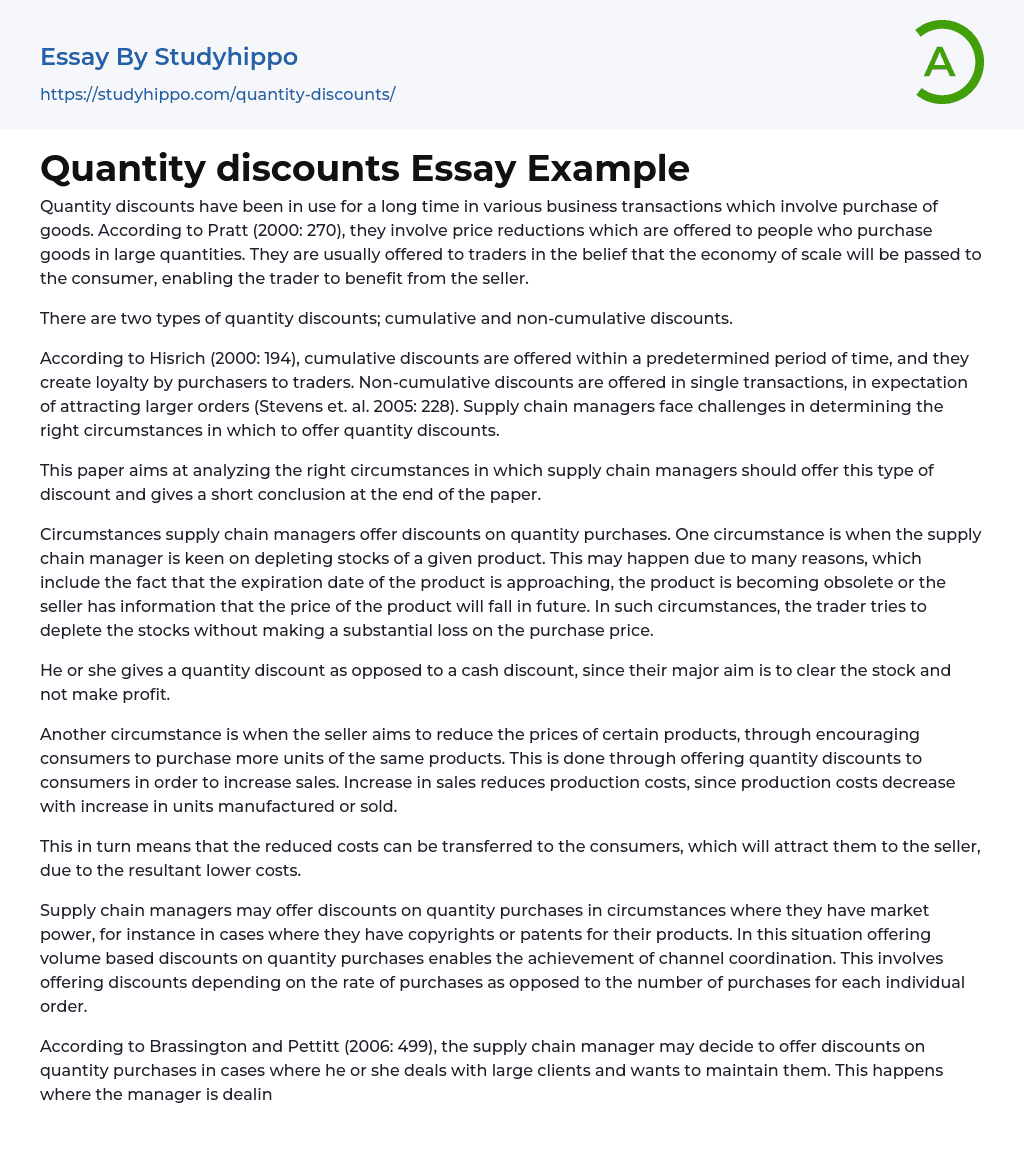Quantity discounts have been in use for a long time in various business transactions which involve purchase of goods. According to Pratt (2000: 270), they involve price reductions which are offered to people who purchase goods in large quantities. They are usually offered to traders in the belief that the economy of scale will be passed to the consumer, enabling the trader to benefit from the seller.
There are two types of quantity discounts; cumulative and non-cumulative discounts.
According to Hisrich (2000: 194), cumulative discounts are offered within a predetermined period of time, and they create loyalty by purchasers to traders. Non-cumulative discounts are offered in single transactions, in expectation of attracting larger orders (Stevens et. al. 2005: 228). Supply chain managers face challenges in determining the right circumstanc
...es in which to offer quantity discounts.
This paper aims at analyzing the right circumstances in which supply chain managers should offer this type of discount and gives a short conclusion at the end of the paper.
Circumstances supply chain managers offer discounts on quantity purchases. One circumstance is when the supply chain manager is keen on depleting stocks of a given product. This may happen due to many reasons, which include the fact that the expiration date of the product is approaching, the product is becoming obsolete or the seller has information that the price of the product will fall in future. In such circumstances, the trader tries to deplete the stocks without making a substantial loss on the purchase price.
He or she gives a quantity discount as opposed to a cash discount, since their major aim is to clear the stock
and not make profit.
Another circumstance is when the seller aims to reduce the prices of certain products, through encouraging consumers to purchase more units of the same products. This is done through offering quantity discounts to consumers in order to increase sales. Increase in sales reduces production costs, since production costs decrease with increase in units manufactured or sold.
This in turn means that the reduced costs can be transferred to the consumers, which will attract them to the seller, due to the resultant lower costs.
Supply chain managers may offer discounts on quantity purchases in circumstances where they have market power, for instance in cases where they have copyrights or patents for their products. In this situation offering volume based discounts on quantity purchases enables the achievement of channel coordination. This involves offering discounts depending on the rate of purchases as opposed to the number of purchases for each individual order.
According to Brassington and Pettitt (2006: 499), the supply chain manager may decide to offer discounts on quantity purchases in cases where he or she deals with large clients and wants to maintain them. This happens where the manager is dealing with big companies or institutions which purchase the products in bulk.
Offering them discounts on such purchases not only helps the seller by decreasing costs, but it also makes these large clients become loyal to him or her, which is beneficial to the business (Butscher 2002: 87-88).
Conclusion and recommendation. Discounts on large purchases have been seen to be very beneficial to the supply chain manager and the sellers at large. It not only increases customer loyalty but it also reduces
the costs of the seller.
It is however important to analyze the character and trends of a consumer, as well as the favorable amount of discount to give, before deciding to offer this type of discount. This is because, if implemented haphazardly, this policy has the potential to cause a business to collapse due to financial strains.
Bibliography
- Brassington, F. , Pettitt, S.
- (2006). Principles of Marketing. 10th edition. New York: FT Prentice Hall.
- Butscher, S. A. (2002). Customer Loyalty Programmes and Clubs. 2nd edition.
- UK: Gower Publishing. Hisrich, R. D. (2000).
- Marketing. 2nd edition. New York: Barron's Educational Series. Pratt, J. (2000). Financial Accounting: In an Economic Context.
- 6th edition. Boston: South- Western College Publishers. Stevens, R. E. , Wrenn, B.
- , Loudon, D. L. , Mansfield, P. (2005).
- 2nd edition. Marketing Planning Guide. New York: Haworth Press.
- Futures Contract essays
- Mortgage Loan essays
- Renting essays
- Transaction Cost essays
- Buying Homes essays
- American Dream essays
- Barriers To Entry essays
- Capitalism essays
- Central Bank essays
- Compensation essays
- Consumerism essays
- Economic Development essays
- Economic Growth essays
- Economic Inequality essays
- Economic System essays
- Economy essays
- Employment essays
- Export essays
- Finance essays
- Free Trade essays
- Gross Domestic Product essays
- Human Development essays
- Income Inequality essays
- Industry essays
- Inflation essays
- International Business essays
- International Trade essays
- Macroeconomics essays
- Materialism essays
- Max Weber essays
- Microeconomics essays
- Minimum Wage essays
- Monetary Policy essays
- Monopoly essays
- Pricing essays
- Profit essays
- Recession essays
- resources essays
- Taxation essays
- Trade essays
- Unemployment essays
- Warehouse essays
- World economy essays
- Advertisement essays
- Advertising essays
- Anheuser-busch essays
- Audience Theory essays
- Brand essays
- Brands essays
- Competitor Analysis essays




